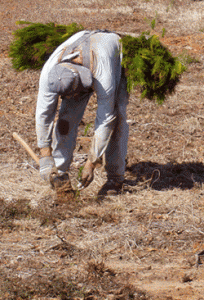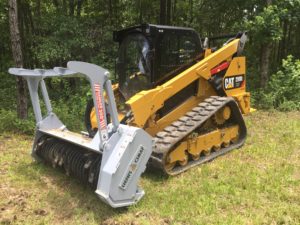A Word From Our Team
Tree Planting in Alabama
 When a tract of land has undergone its’ final harvest, it is important to have a plan in place for the next rotation. We often recommend waiting 8 months to a year between cutting timber and replanting to avoid seedling mortality from the Pales Weevil. Although this weevil rarely causes trouble, it is certainly a smart management practice. Most tracts that we plant this year will be loblolly pine. Loblollys make great plantation trees and can be ready for a first thinning as early as 12 years of age. We will plant some slash pine and longleaf pine this year as well due to differing soil types as well as differing landowner objectives.
When a tract of land has undergone its’ final harvest, it is important to have a plan in place for the next rotation. We often recommend waiting 8 months to a year between cutting timber and replanting to avoid seedling mortality from the Pales Weevil. Although this weevil rarely causes trouble, it is certainly a smart management practice. Most tracts that we plant this year will be loblolly pine. Loblollys make great plantation trees and can be ready for a first thinning as early as 12 years of age. We will plant some slash pine and longleaf pine this year as well due to differing soil types as well as differing landowner objectives.
We are planting over a million seedlings this year in Alabama!
Caterpillar Skid Steer Mulcher
We are excited to announce Carlson Land Services’ latest update! In addition to our two bulldozers and excavator, we have recently gotten a Caterpillar skid steer mulcher! This piece of equipment is excellent for grinding up thick, overgrown areas and turning them into a beautiful, functional, part of your property. Mulching can also be a great control for undesirable natural stems in your timber stand. This skid steer has a one-day minimum and can be used for several types of work. Please call us today if you are interested in having some mulching done on your property or want to learn more!
Pictured below is some recent roadside clean-up work we have done on a client’s property to help improve wildlife habitat as well as aesthetics.
Forest Management Practices, BMP’s, and Prescribed Fire after Logging
There are hundreds of ways to help maintain a healthy forest. One of the major practices that we perform every year is cutting timber. We help our clients decide when the best time for them to cut timber would be based on their personal objectives, and then perform our timber sale.
After the timber is sold and the trees are cut down, there is still much to do. If the harvest involved a clearcut, we must think about raking up slash with our dozier, burning the slash, and replanting the stand. If we are just thinning a tract we still want to clean the roads and debris in the woods as much as the landowner desires.
One practice that we are working on this time of year is burning off the logging ramps. When trees are processed in the woods, everything that does not go onto the logging truck is left in the woods. This includes limbs, bark, cat faced butts of logs, deformed sections of the tree that couldn’t be taken to the mill, and tops of trees. We ask the logger to pile all this debris so that we can burn it when the time is right.
When is the time right? There are several factors that go into a successful fire of this kind of magnitude. To begin, never set fire without good fire lanes. Managing big fires takes having the right equipment. We rarely set fires without a bulldozer or tractor, ATVs, water tanks and hoses, drip torches, and sufficient manpower.
We give these piles a few months to dry up and be ready to burn. We then wait for the right day/ night to burn which includes high humidity, low winds, and low air temperatures. These conditions will minimize chances for fires escaping or embers lighting adjacent woods on fire. These kinds of fires are magnificent to watch and difficult to capture in a picture.
Feel free to contact us for further information.




